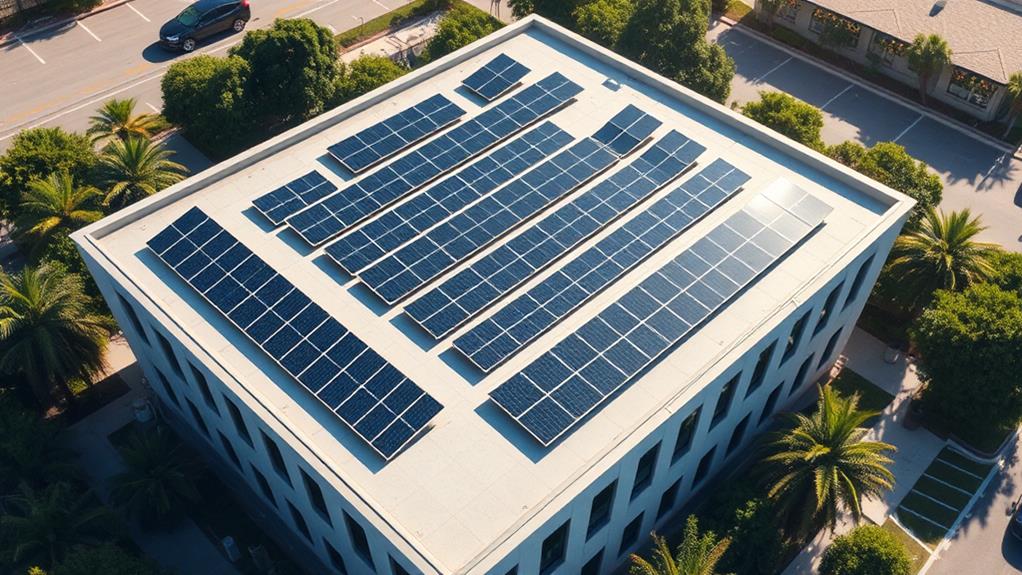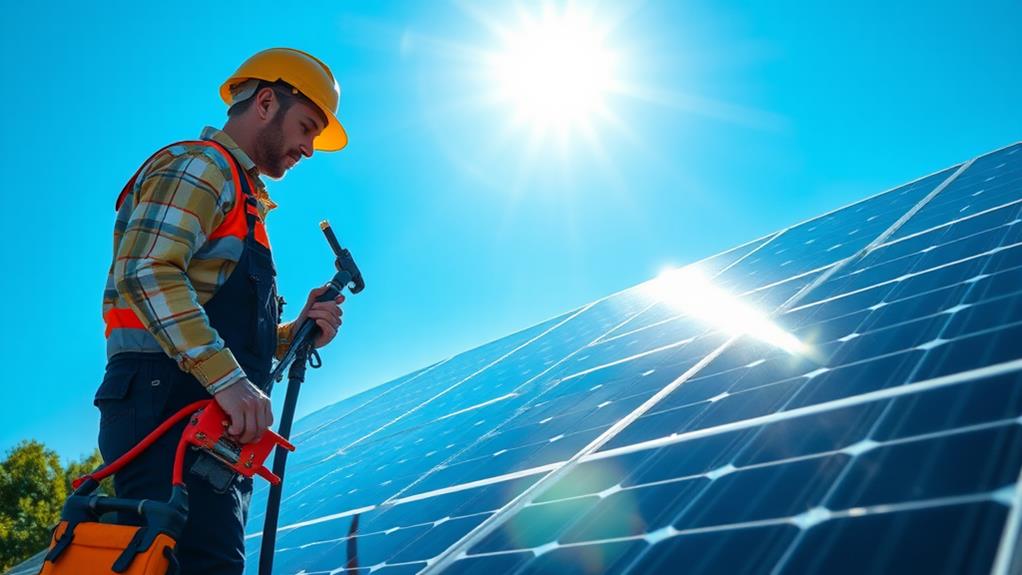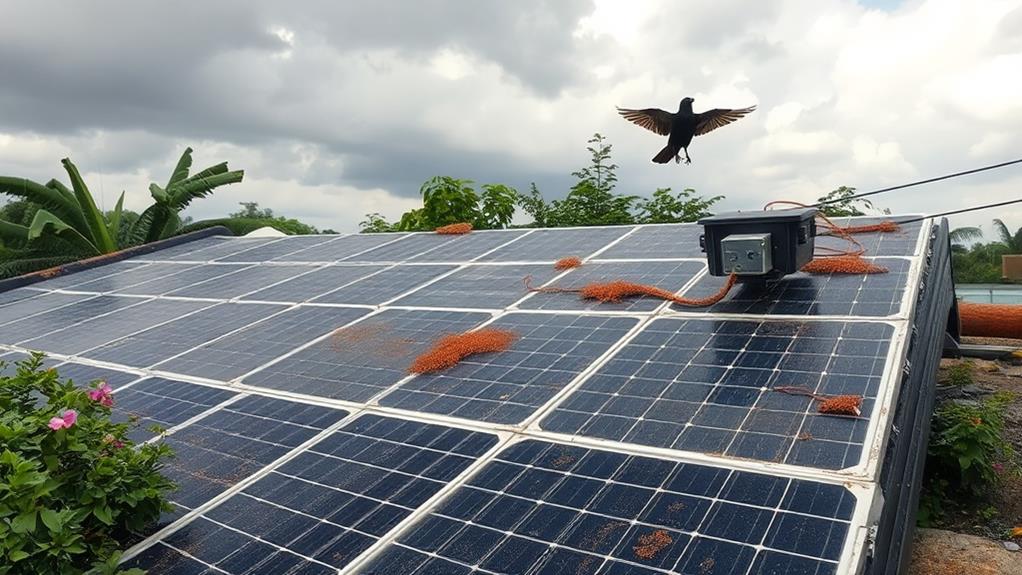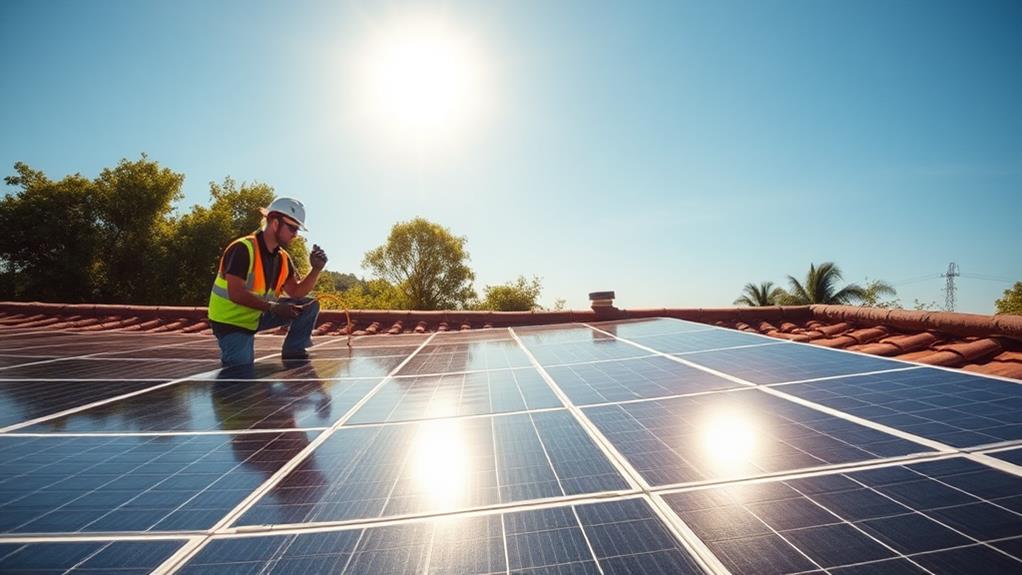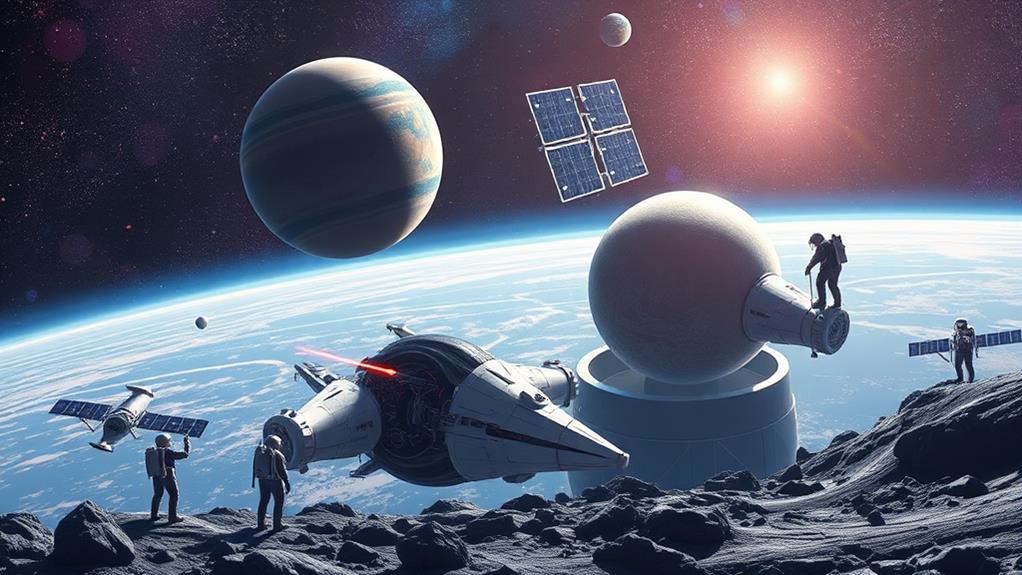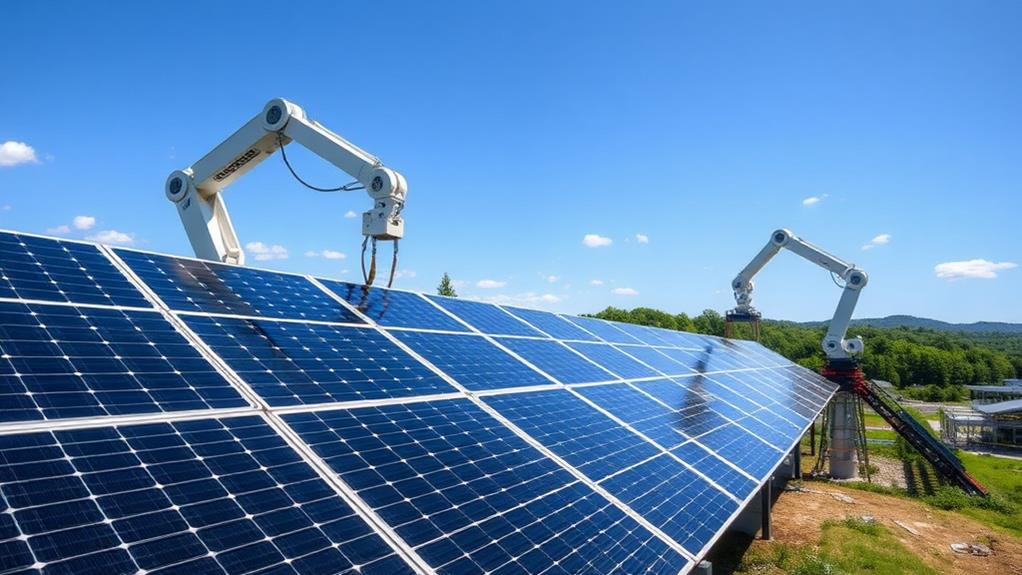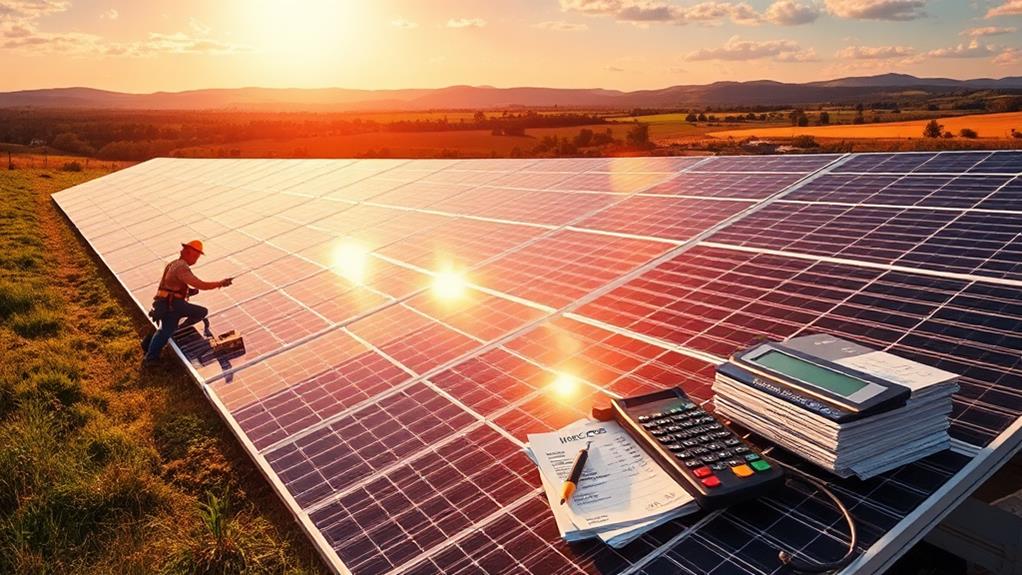Let's examine how installing solar panels on commercial properties offers substantial advantages. We can greatly reduce electricity expenses and achieve a return on investment in 4-7 years. With tax credits and rebates, investing in solar becomes more accessible. Adopting solar power not only improves our brand image but also aligns us with environmental objectives, attracting eco-conscious consumers. We have a range of installation choices, from rooftop to ground-based systems, to optimize sunlight exposure and efficiency. Navigating local permitting and financing options might seem challenging, but with expert guidance, we can harness solar energy's full capacity. Explore more possibilities ahead.
Key Takeaways
- Commercial solar installations reduce electricity bills and offer a return on investment within 4-7 years.
- Rooftop and ground-based systems are available, with location choice depending on space and sunlight exposure.
- Financing options like solar loans and tax credits reduce costs and enhance savings.
- Quality installation and regular maintenance maximize the efficiency and lifespan of solar panels.
- Experienced contractors simplify the permitting process and overcome space limitations for installations.
Benefits of Commercial Solar
When investing in commercial solar, benefits are substantial and tangible. Solar power systems significantly reduce electricity bills, leading to long-term cost savings for businesses. Generating clean and renewable energy on-site not only cuts costs but contributes to sustainability efforts. This aligns businesses with a community that prioritises environmental responsibility.
The financial appeal of solar power systems can't be overstated. Many projects offer a return on investment within 4-7 years. Incentives, such as tax credits and rebates, make the initial investment more manageable, allowing businesses to enjoy the advantages of solar energy sooner.
For example, the Tesla Solar Roof offers an innovative solution combining aesthetics and efficiency, while the LG NeON 2 solar panels are renowned for their high performance and reliability.
Commitment to clean energy enhances brand image. Meeting environmental goals reflects a dedication to a healthier planet, resonating with clients and partners sharing similar values. With low maintenance requirements and lifetime warranties, solar systems provide a reliable and efficient energy solution. This strengthens a business's foundation for the future.
Installation Options for Businesses
When considering solar installations for our commercial properties, we've got rooftop and ground solutions to consider. The decision often hinges on our available space and how much sunlight each area receives.
With options like rooftops, carport roofs, and open land, we can work with experts like Texas Solar Group to find the best fit for our needs.
Rooftop and Ground Solutions
Companies aiming to utilise solar energy have two main installation options: rooftops and ground-based systems. Rooftop installations, especially on flat surfaces, offer an efficient and space-saving solution for solar integration. These systems allow businesses to incorporate renewable energy into existing structures such as rooftops and carport roofs, maximising energy use without occupying valuable land.
Ground-based systems are suitable for businesses with available open land. These installations need ample sunlight and unobstructed space, making them ideal for properties with sufficient real estate. Ground-based solar panels can significantly enhance energy production while considerably reducing a company's carbon footprint.
The choice between rooftop and ground-based installations depends on factors like space availability and sunlight exposure. Experts like Texas Solar Group provide guidance through this decision-making process, offering comprehensive analysis and support to determine the most effective locations for commercial solar arrays.
Embracing either of these solutions not only reduces energy costs but also aligns with a commitment to sustainability and innovation.
Space and Sunlight Considerations
Selecting the proper location for solar panel installation requires careful consideration of space and sunlight. We all aim to optimise our solar investments; choosing ideal installation spots is crucial. Commercial properties can benefit greatly from solar arrays, but the success of these installations largely depends on the presence of unobstructed sunlight. For businesses with open land, ground-mounted panels are a practical choice, flourishing in areas with abundant sunlight and minimal obstructions.
Rooftops offer another excellent solution for solar installations. Many underestimate the potential of a building's rooftop, but it can be the ideal location for flat panel installations. These solar arrays efficiently capture sunlight, converting unused space into a sustainable energy source. Carport roofs also present an alternative for those seeking to optimise their space while reaping the benefits of solar energy.
Texas Solar Group can assist in analysing a property's unique characteristics and identifying the best installation spots. Selecting the right location improves a building's energy efficiency and contributes to a more sustainable future for the community. Making informed decisions and joining the solar movement is essential for progress.
For specific recommendations, the LG NeON 2 solar panels are known for their high efficiency and durability. These panels are ideal for both rooftop and ground-mounted installations, ensuring maximum energy capture.
Another excellent choice is the SunPower Maxeon 5 series, offering unmatched performance and a sleek design suitable for various applications.
When considering costs, it's important to remember that prices may vary, but investing in quality solar panels can lead to significant savings. While initial costs might be higher, the long-term benefits and reduction in energy expenses make it a worthwhile investment. Prices, though dependent on various factors, are often quoted in South African Rand.
Financing Solar Projects
Funding solar projects for commercial properties requires navigating various options and incentives. Several financing options are available such as Purchase Power Agreements (PPAs), solar loans, and SBA loans, each tailored to meet distinct financial requirements. These options increase accessibility to solar installations, enabling everyone to find a suitable path to solar energy.
Federal tax credits and depreciation benefits significantly reduce the overall cost of solar projects. These incentives allow for offsetting a substantial portion of the investment, making the switch to solar more financially attractive. Additionally, some states and utility companies offer further tax credits or rebates, enhancing our potential savings.
Calculating the payback period is essential to understand the financial feasibility of solar installations. This requires evaluating system size, installation costs, and expected energy savings. Such an analysis helps determine how quickly the investment will recoup its costs and begin generating real savings on electricity bills.
For instance, using high-quality solar panels like those from SunPower can improve efficiency and shorten the payback period, leading to quicker financial benefits.
Technical Considerations
Understanding the technical aspects of solar installations for commercial properties is crucial for long-term success. It's essential to ensure our investment is both cost-effective and sustainable. Commercial solar panels have a lifespan of 25 to 30 years, making them a durable choice for businesses aiming to reduce their carbon footprint. Quality installation is of utmost importance as it impacts the panels' efficiency and longevity.
Installation expenses can vary and often include necessary permits, engineering reviews, and PE stamps, all critical for compliance and safety. Hiring experienced professionals guarantees that each step meets industry standards, protecting our investment. Regular maintenance and proper care are equally important in extending the operational life of our panels.
The lifespan of our solar panels is influenced by factors such as material quality and manufacturing standards. Prioritising high-quality materials and workmanship aligns us with a community focused on sustainable practices. Investing in quality installation and ongoing maintenance means joining a forward-thinking network committed to a cleaner future. Making informed choices contributes to this shared vision.
For example, Trina Solar panels are renowned for their efficiency and durability, offering an excellent option for commercial installations.
Furthermore, ensuring the use of reliable inverters like those from SMA Solar Technology can enhance the overall performance of the system.
Marketing and Branding Impact
Focusing on the technical aspects of solar installations, their impact on marketing and branding is noteworthy. Embracing solar energy represents more than a commitment to clean energy; it sends a strong message to consumers who prioritise sustainability.
Commercial properties featuring solar power convey a message that resonates with the growing consumer demand for environmentally friendly products and services. This alignment enhances brand image, positioning companies as leaders in the shift towards a sustainable future.
In today's competitive market, adopting solar reflects not only environmental responsibility but also a strategic marketing choice. Large corporations aim for ambitious carbon-neutral goals, with solar installations playing a crucial role in achieving these targets.
Demonstrating a commitment to clean energy sets companies apart, attracting a community that appreciates eco-friendly practices. For small and medium-sized enterprises, solar systems boost brand image and offer a unique selling point.
Communicating about solar installations becomes an effective marketing tool. Sharing the journey in clean energy highlights dedication and inspires others to contribute positively to the environment.
Solar panels from reputable brands such as SunPower and LG can be showcased to further emphasise commitment to quality and sustainability.
Calculating Energy Savings
Understanding the energy savings from commercial solar panels is essential to evaluating their complete value. Investing in solar involves more than just the panels themselves, as factors such as system size, location, and energy consumption patterns significantly influence outcomes. Analysing local solar resources and electricity rates allows us to estimate projected energy production and potential savings accurately.
Financial incentives like tax credits and rebates can significantly increase overall energy savings. These incentives not only lower initial costs but also shorten the payback period, making solar installations more attractive for businesses. Taking advantage of these opportunities strengthens our financial position and contributes to a collective move towards sustainability.
Efficient system design and regular maintenance are crucial for maximising energy savings over the system's lifespan. It's not just about installing solar panels; it's about ensuring they perform optimally over time. Analysing the payback period and return on investment provides insight into the long-term benefits of transitioning to solar energy. Informed decisions aligned with our values foster a sense of belonging in a sustainable future.
For example, the SolarEdge commercial inverter is known for its high efficiency and reliability, making it a good choice for businesses looking to maximise their solar investment. High-quality panels like those from LG or SunPower can further enhance savings.
Regular maintenance, such as cleaning panels and checking connections, ensures optimum performance and prolongs the system's life.
Overcoming Solar Challenges
As we consider solar installations for commercial properties, tackling permitting complexities and space limitations is vital.
Grasping local regulations and collaborating with experienced providers can ease the permitting process.
Moreover, innovative design solutions can help us make the most of limited roof space or challenging building orientations.
Navigating Permitting Complexities
Navigating the complexities of permits for commercial solar installations demands a thorough understanding of local zoning laws and building codes. Each area has its own set of requirements, which can be intricate. To ensure our project complies with these regulations, we must secure detailed engineering plans and adhere to specific inspection criteria. Though this process can seem overwhelming, it's crucial to avoid costly delays.
Working with experienced solar contractors simplifies the path. These professionals possess a keen understanding of local laws and expertly guide us through the paperwork and approval processes. They assist in preparing accurate documentation and submitting permit applications efficiently. This expertise ensures all necessary approvals are secured without unnecessary setbacks.
Permitting challenges can extend the timeline and increase the cost of a solar project.
For example, in Johannesburg, compliance with local regulations may add additional weeks to the schedule and potentially increase costs by tens of thousands of South African Rand. Thorough planning and preparation are essential. As part of a community committed to sustainable energy solutions, overcoming these challenges brings us closer to achieving a greener future.
Addressing Space Limitations
Installing solar panels on commercial properties with limited space requires inventive solutions. Rooftop panels are an effective approach, transforming unused roof space into a green energy hub. Even properties with minimal land can join the solar movement. Carport roofs offer another smart solution, converting parking areas into energy-generating assets.
Ground-mounted solar arrays may not be suitable for properties with space constraints, yet solar energy's benefits remain accessible. Texas Solar Group can help assess these limitations and recommend the optimal solar installation strategies tailored to specific needs. Innovative designs such as raised solar panels or vertical installations optimise energy production without needing extensive land.
These challenges don't prevent us from enjoying both the financial savings and environmental advantages solar energy provides. Strategic installation methods allow us to overcome space limitations while contributing to a sustainable future. This fosters a sense of belonging within the growing community of solar users.
Conclusion
We have explored the many benefits of solar installations for commercial properties, such as cost reduction and enhanced brand image. Businesses can successfully incorporate solar energy into their operations by considering various installation options and financing methods. It's crucial to address technical factors and calculate potential energy savings to maximise returns. Challenges may arise, but they can be managed with careful planning and strategic marketing.
Deo Solar is here to help you navigate this transition. If you have questions about our products—Rail-Less Solar Brackets, End Spacers, Structural Brackets, Ground Mounted Solar Systems, Corrugated Brackets, Earthing Plates—or our services—DeoSizer Tool, Evaluation and Design, Maintenance and Support, Solar Installations—please contact us. Together, we can embrace solar energy and move towards a sustainable future for your business.

